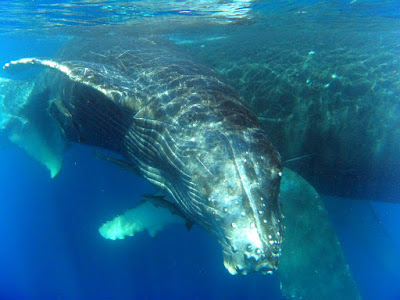Our next two days have been spent on the open water,
masks, snorkels, and fins at the ready to observe the humpback whales that
frequent the area. Unlike the more
touristy island of Vavua, the guides here are much more respectful of the
whales, and there is much less competition.
So the boats never come closer than 150 feet from the whales,
approaching from the side; and no more than four persons and a guide are
allowed to approach a whale at any one time.
Much of the 7-hour boat trip is taken up by a search for females and
their calves resting at the surface.
15-foot
flipper slapping the water
During the
search, you might see whales slapping the water with their huge pectoral fins
or tails; if you are really lucky, one of them might even put on a show for
you, breaching near your boat. Sometimes
they even poke their heads out of the water to see what’s going on; their
vision is just as good above the surface as it is below the surface.
Whale breaching near our boat
Whale calf observing the tourists
Tourist preparing to enter the water
These two days have been a fantastic experience. Several times we were able to approach to
within a few feet of mothers and the calves that were born recently in the area
adjoining Foa Island. It is always a
single calf, about 15 feet long, with a mother often exceeding 50 feet. Sometimes the calf has developed a sense of
curiosity, coming up take a close look at the swimmers.
Whale and snorkeler at the surface
Snorkeling near a big one
Calf and mother
Years ago,
someone observed that whales’ tails are like people’s faces—you can identify
and therefore name each whale based on markings on the tails. That has enabled the marine biologists to
show that the same whales return to Foa each year, making the incredible 5,000-kilometer
trip from Antarctica without eating, and arriving in time to give birth, and
afterward to mate again if they are interested.
Some of the females do not mate every year, but during their 80-year
lifespan they produce quite a number of calves.
No one can explain how they can navigate over the same course on the way
north, or how they know to take an entirely different course back south to
Antarctica.
Calf
near the surface
Calf
coming at us
What an
amazing first two full days in Tonga it has been.
Charlie and Tricia
© 2015









No comments:
Post a Comment